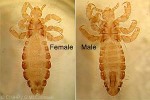Cook Islands Biodiversity Database
Species Page
Pediculus humanus
Kutu TangataHuman Louse
Multimedia & Additional Resources
| Type | Description | Download |
| Adult female & male | 38KB | |
| Head Louse vs Public Louse | 34KB |
General Information
Cook Islands Distribution
| Southern Group: Present Makatea: Present | ||||||||
RR |
MG |
AT |
MK |
MT |
AK |
PL |
TK |
MN |
++++ |
P |
+++ |
+++ |
+++ |
+++ |
+++ |
- |
- |
| Northern Group: Present | |||||
TN |
MH |
RK |
PK |
NS |
SW |
+++ |
+++ |
+++ |
+++ |
+++ |
- |
Pests & Hosts
| Relationship | Hosts |
| Parasite - external | Homo sapiens, |
Scientific Taxonomy
Pediculus humanus L., 1758
SYNONYMS: Pediculus humanus humanus [for Body Louse as a subspecies]; Pediculus humanus capitis [for Head Louse as a subspecies]; Pediculus capitis [for Head Louse as a separate species]
TAXONOMY: ANIMALIA; ARTHROPODA; ATELOCERATA; HEXAPODA; INSECTA; PTERYGOTA; Phthiraptera; Anoplura; PEDICULIDAE. COMMENT: There is much taxonomic confusion between the Body Louse and Head Louse on people. The Body Louse was named first: Pediculus humanus Linnaeus, 1758. Nine years later, in 1767, de Geer named the Head Louse as a subspecies: Pediculus humanus capitis. If each is recognised as a subspecies the Body Louse's correct name is Pediculus humanus humanus.
In recent years there as been increasingly strong evidence that the Body Louse and Head Louse cannot be separated by behaviour, morphology, or molecular composition. Therefore most experts remove the subspecies recognition and combine them as: Human Louse (Pediculus humanus) (as in this database).
An extreme and increasing difficult position to justify maintains that there are actually two species: Body Louse (Pediculus humanus) and Head Louse (Pediculus capitis). [3/2004, G.McCormack based on data on www.phthiraptera.org]
More Information
SIGNIFICANCE NOTES -
NEGATIVE SIGNIFICANCE: Ectoparasite of people - mild. Comments: A common louse NBSAP - Te Au-o-Tonga (11 of 11 animal pests), NBSAP - Aitutaki (10 of 10 animal pests), NBSAP - Mauke (8 of 10 animals)
GENERAL NOTE: Eggs hatch in about 9 days, nymph stages last about 9 days, and adults can lay eggs within four days and live about a month. (sometimes 7 weeks).
Reactions of people to the bite vary from unnoticed to severe itching. Usually each bite develops in a few hours into small, reddish papules that itch.
Head Louse can transmit diseases. For example Epidemic Typhus can spread in louse faeces, and has been epidemic in the past. It has also been said that "it is more dangerous for a man to bite a louse than a louse bite a man", for example, Budonic Plague and Relapsing Fevers are spread when infected louse are crushed on the body or bitten with the teeth.
The Head Louse was a feaure of ancient Polynesia. For example, in Hawai‘i the louse known as ‘Uku appears in the place name Wainaukepo‘o on Hawai‘i island and refers to a place for streamside delousing. Delousing was "nauke" and snaping them between the fingernails is "ho‘u‘ina", and between the teeth is "aki". Head Louse were ‘Uku-po‘o, while Body Louse were ‘Uku-kapa, meaning "louse of the Tapa cloth".
Vouchers & References
Vouchers:
Pukapuka: fieldspecimen, 2/2004, G.McCormack with ID as Pediculus humanus.
References:
None recorded.
Data Update History (information):
zTX, zB02, zM04a, zD02
Web Resources
Citation Information
McCormack, Gerald (2007) Cook Islands Biodiversity Database, Version 2007.2. Cook Islands Natural Heritage Trust, Rarotonga. Online at http://cookislands.bishopmuseum.org. ![]()
Please refer to our use policy.

